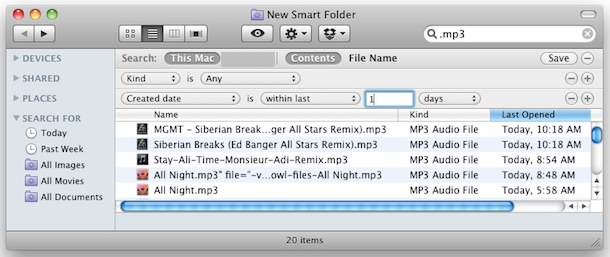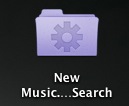How to Use Smart Folders in Mac OS X

One of the underused and certainly under appreciated features of Mac OS X are Smart Folders. If you aren’t familiar with Smart Folders, they essentially let you create a virtual folder that uses search operators from Spotlight to let that virtual folder contain any and all files that match the search requirements. Sound confusing? It’s really not, here’s a practical example:
I download a lot of music from various new music blogs around the web, due to the nature of quickly downloading, some of these files end up in my Downloads folder and others on the Desktop. Instead of digging around in both locations for newly downloaded files, I just created a smart folder that searches for .mp3 files created within the past day. Suddenly all the new music is now contained within one folder which I can then use to directly import into iTunes and then delete the leftover files.
How to Create a Smart Folder in Mac OS X
The easiest way to create a smart folder is outlined below, then once the New Smart Folder window is open it’s time to customize the virtual folder with some operators.
- Make a new Smart Folder by hitting Command+Option+N in the Finder, or by going to the File menu and choosing “New Smart Folder”
- Click into the “Search” box
- Hit the + icon next to ‘Save’ to add generic operators like File type, File Creation Date, Modified Date, Name, Contents, or a slew of other possibilities in ‘Other’
- Use the Search box to use search operators from Spotlight, for specific file types you can type extensions like .mp3 .psd .mov, etc
- Once you have established some operators for the Smart Folder, hit “Save” in the upper right corner of the window
- Give the Smart Folder a name and choose to either add it to your Finder sidebar or save it to any location you’d like

You’ll now be able to access that Smart Folder like any other folder in the Finder and it will have saved the search operators. Note that Smart Folders icons are shaded purple and have a gear icon on them (see image to the right) so they are easy to identify in the future. Smart Folders update on their own, so anytime you open the folder it will change based on the factors you created it under. And remember, if you delete a Smart Folder, it will not effect the files within it.
If you want more ideas for Smart Folders, I would recommend testing out some of the search parameters and seeing what you get, it’s a great yet underused Mac OS X feature.


FYI:
The Command+Option+N shortcut does not seem to work.
Command+Option+N is standard for US keyboards to create a new Smart folder in Mac OS, but it may not be on some other keyboard configurations.
If it’s not working for you then from the Finder, select a few files, then pull down the “File” menu to locate “New Smart Folder” under that dropdown menu, alongside that you will see the keyboard shortcut.
Please! If there is a way to print the smart folder window of files, I would Love to know about it!
Thanks
Alberto: No, Spotlight continually indexes your Mac. A Smart Folder merely makes use of that information, much like typing some text in the Spotlight search box in the upper right corner would do. Since the information is already indexed, both using Smart Folders and the Spotlight search box will be very fast and not tax your system more than it does by having the Spotlight service run (which it always does by default, and I don’t notice it much).
I think that it makes a continuous search on your(s) HD(s), and for this slows the reactivity or you Mac.
(Or not?)
I saw this on MW earlier, definitely worth learning how to use